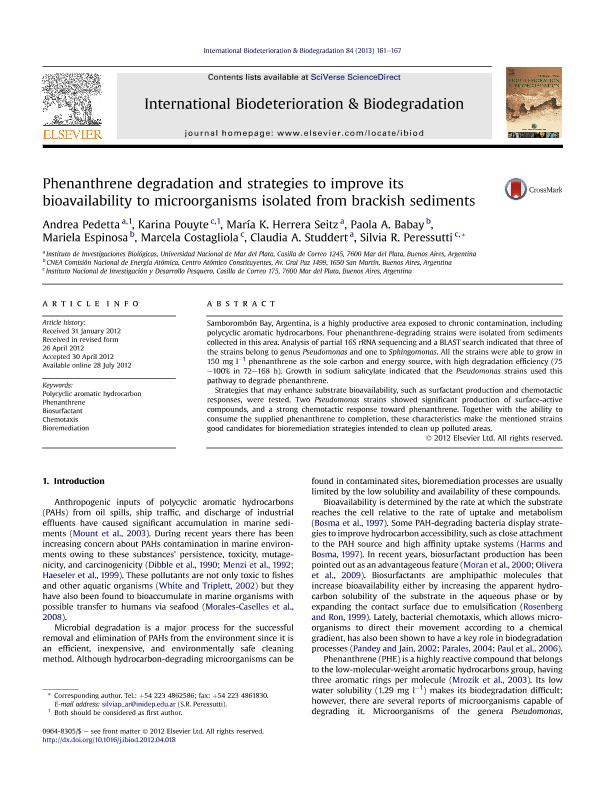Artículo
Phenanthrene degradation and strategies to improve its bioavailability to microorganisms isolated from brackish sediments
Pedetta, Andrea ; Pouyte, Karina; Herrera Seitz, Karina
; Pouyte, Karina; Herrera Seitz, Karina ; Babay, Paola Alejandra; Espinosa, Mariela; Costagliola, Marcela; Studdert, Claudia Alicia
; Babay, Paola Alejandra; Espinosa, Mariela; Costagliola, Marcela; Studdert, Claudia Alicia ; Peressutti, Silvia R.
; Peressutti, Silvia R.
 ; Pouyte, Karina; Herrera Seitz, Karina
; Pouyte, Karina; Herrera Seitz, Karina ; Babay, Paola Alejandra; Espinosa, Mariela; Costagliola, Marcela; Studdert, Claudia Alicia
; Babay, Paola Alejandra; Espinosa, Mariela; Costagliola, Marcela; Studdert, Claudia Alicia ; Peressutti, Silvia R.
; Peressutti, Silvia R.
Fecha de publicación:
10/2013
Editorial:
Elsevier
Revista:
International Biodeterioration and Biodegradation
ISSN:
0964-8305
Idioma:
Inglés
Tipo de recurso:
Artículo publicado
Clasificación temática:
Resumen
Samborombón Bay, Argentina, is a highly productive area exposed to chronic contamination, including polycyclic aromatic hydrocarbons. Four phenanthrene-degrading strains were isolated from sediments collected in this area. Analysis of partial 16S rRNA sequencing and a BLAST search indicated that three of the strains belong to genus Pseudomonas and one to Sphingomonas. All the strains were able to grow in 150mgl-1 phenanthrene as the sole carbon and energy source, with high degradation efficiency (75-100% in 72-168h). Growth in sodium salicylate indicated that the Pseudomonas strains used this pathway to degrade phenanthrene.Strategies that may enhance substrate bioavailability, such as surfactant production and chemotactic responses, were tested. Two Pseudomonas strains showed significant production of surface-active compounds, and a strong chemotactic response toward phenanthrene. Together with the ability to consume the supplied phenanthrene to completion, these characteristics make the mentioned strains good candidates for bioremediation strategies intended to clean up polluted areas.
Archivos asociados
Licencia
Identificadores
Colecciones
Articulos(IIB)
Articulos de INSTITUTO DE INVESTIGACIONES BIOLOGICAS
Articulos de INSTITUTO DE INVESTIGACIONES BIOLOGICAS
Citación
Pedetta, Andrea; Pouyte, Karina; Herrera Seitz, Karina; Babay, Paola Alejandra; Espinosa, Mariela; et al.; Phenanthrene degradation and strategies to improve its bioavailability to microorganisms isolated from brackish sediments; Elsevier; International Biodeterioration and Biodegradation; 84; 10-2013; 161-167
Compartir
Altmétricas



